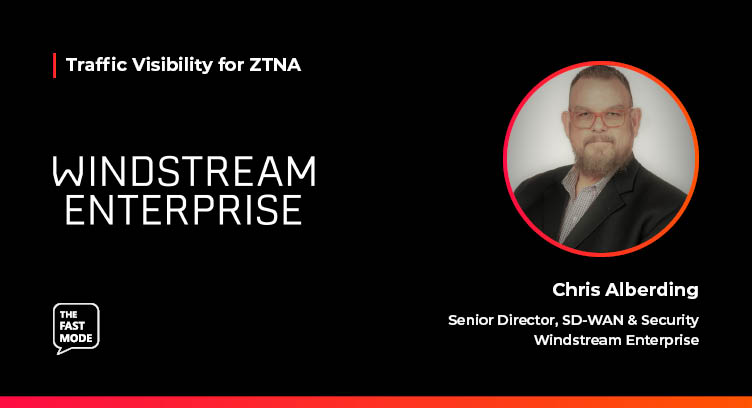The Fast Mode spoke to Chris Alberding, Senior Director for SD-WAN & Security at Windstream Enterprise on the impact of traffic visibility on ZTNA networks. Chris joins us in a series of discussions with leading cybersecurity and networking vendors, assessing the evolution of ZTNA technologies, the roadmap for ZTNA deployments, the benefits of ZTNA for enterprise and telco networks, and the need for real-time traffic visibility technologies such as DPI for ZTNA.
Ariana: How does ZTNA enhance telecom operator networks?
Chris: Telecom operators continue to experience cyberthreats from all angles, which doesn’t appear to be waning anytime soon. These never-ending risks are detrimental to technical and business viability in the digital transformation era, where critical business data is stored, accessed and used regularly. Existing network architectures are designed on implicit trust - not zero trust - so they must either be rebuilt or replaced, which are difficult and expensive options.
The difficulty of updating legacy systems drove the need to enable organizations to transition to Zero Trust at their own pace. Considering the ongoing risk from cyberthreats, the U.S. government’s Cybersecurity and Infrastructure Agency (CISA) proposed a Zero Trust Maturity Model as a flexible template for enterprises to use. Organizations are encouraged to select the appropriate tools for achieving Zero Trust Maturity while also ensuring holistic security is part of this process.
At Windstream Enterprise, we are helping telcos map CISA’s model to transition to Zero Trust with our Secure Access Service Edge (SASE) and Security Service Edge (SSE) solutions powered by Cato Networks. These secure digital transformation platforms facilitate Zero Trust Maturity, while also protecting access at the edges, including sites, mobile users and devices, and enterprise and cloud resources.
This enables organizations to move away from rigid and disjointed IT architectures to converged security platforms. The results are significantly reduced costs and easier management through a single pane of glass that automatically evolves defenses and mitigates emerging threats. It’s an ironclad security architecture that seamlessly implements Zero Trust access and defends against anomalies, cyberthreats and sensitive data loss.
Ariana: What do you consider are the core features (must have) of ZTNA?
Chris: The foundation of Zero Trust is based upon 3 core functions:
- Identity: Who are you, and why are you on my network?
- Device: Is your device safe to access my network and application resources?
- Network Security: Can you connect users and devices to applications while protecting data everywhere?
The beauty of solutions like Windstream Enterprise SSE, powered by Cato, is that it takes a risk-based approach to Zero Trust. It helps organizations identify, assess, control and continuously evaluate the potential risk posed by users, devices, apps and services, then adapt accordingly with minimal effort or impact on the user experience.
Windstream Enterprise SSE provides complete security coverage while supporting many attributes across the Zero Trust Maturity pillars. Additionally, the SSE private network gives organizations the visibility of all users, application data, and network flows for richer security analytics to automate and adapt the security posture and reduce potential blind spots.
Chris Alberding is the Senior Director for SD-WAN & Security at Windstream Enterprise. Chris oversees the company’s network and security solutions, and has global responsibilities for product revenue forecasts and budgets, as well as strategic and tactical expertise in product management, marketing, process design and sales operations.
This interview is a part of The Fast Mode's Next-Gen DPI Traffic Visibility for ZTNA segment, featuring over 40 leading cybersecurity and networking solution providers and their views on the importance of traffic visibility for ZTNA. A research report on this topic will be published in January 2024 - for more information, visit here.



















